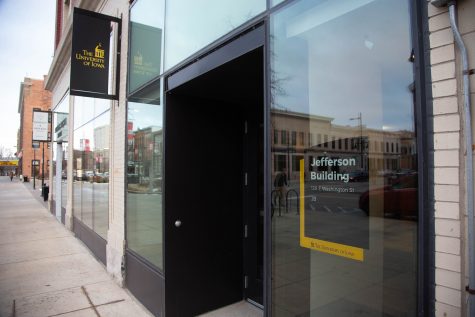West Side Food Pantry celebrates one-year anniversary to combat food insecurity
With one year under its belt, the University of Iowa West Side Food Pantry is determined to promote inclusivity by diversifying the items it provides and educating the community on ways to combat food insecurity unity.
Tate Hildyard for The Daily Iowa
The West Side Food Pantry is seen in the University of Iowa Pride Alliance Center on Tuesday, Feb. 25, 2020. The pantry is about to celebrate its first year in the Pride Alliance Center.
February 26, 2020
The University of Iowa West Side Food Pantry, located in the UI’s Pride Alliance Center, celebrated its first anniversary in 2020. Leaders reflected on the year’s successes and are preparing to diversify their supply of food and hygiene products to be more inclusive as part of their goals for the year ahead.
Since the beginning of 2020, Food Pantry at Iowa Executive Director Charlotte Lenkaitis said the west-side location distributed 296.5 pounds of food to clients in 26 visits. Since fall 2019, both the UI east and west side food pantries distributed 11,597 pounds of food between 886 visits.
“In our second year, [the UI West Side Food Pantry is] definitely now focusing on not only increasing the amount of culturally diverse food and hygiene products … but also promoting advocacy and awareness about the pantry,” Lenkaitis said.
In January, she led a retreat in which the executive team for the west-side location established goals for the new year. She said a goal moving forward is to reach out to state lawmakers and students on campus to promote both the existence and the mission of the food pantry to curb food insecurity.
UI West Side Food Pantry Manager Oluoma Obi said the Pride Alliance Center allowing the pantry to set up in its west-side space was key to jumpstarting the new food service.
“Cultural houses are a safe space where people identify within a particular culture can feel welcome and comfortable,” Obi said. “Allowing clients to come through and openly allow them to walk through their space was really vital to the [pantry’s] success.”
From fall 2016 to fall 2019 of those visiting the Food Pantry at Iowa, including both east- and west-side locations, 69.9 percent of the clients were women and 30.1 percent were men. Demographically, 43 percent of clientele were white, 23 percent were black/African American, 17 percent were Asian, and 17 percent Hispanic and Latinx. First-generation students made up 29 percent of visitors.
While the UI East Side Food Pantry receives a lot more clientele and is the first point of contact, Obi said, the UI West Side Food Pantry creates a more intimate space and serves a more demographically diverse share of visitors with the pantry’s close proximity to the UI’s cultural ad resource centers.
RELATED: Food Pantry at Iowa brings new location to west side
Using the UI’s ID-card swipe system, Lenkaitis said the West Side Food Pantry is looking to build up its own collection of demographic data separate from the East Side Food Pantry’s collection. The goal is to provide more ethnically diverse foods and hygiene products.
“On the west side, we tend to see more graduate students, international students and people of color,” she said. “We want more diversity as we both create and expand locations, because we ultimately do not all eat or need the same things.”
Obi said her main focus is diversity within the pantry, adding that she wanted the pantry to be a staple of the UI community’s inclusive environment. She said pantry leaders are planning to send out a survey to collect feedback on what kind of products clientele want in order to diversify what they offer.
“In the first year, we struggled with consistency in items, so people did not feel like they could come back to get what they needed,” Obi said. “To grow the clientele, I want to rebuild that trust.”
Media Strategist for the West Side Food Pantry Joanna Moody said her goal is to continue to promote ways through social media to combat food insecurity. She wants to target college students specifically, as the number of food-insecure students continues to rise dramatically, she said.
According to the American Journal of Public Health, multiple studies show rates of food insecurity among college students range from 20 percent to more than 50 percent, which is considerably higher than the entire U.S. population’s 12 percent rate.
“People do not realize how common food insecurity is,” she said.
Obi added that the stigma of food pantries often prevents people from using it, as they don’t feel comfortable admitting they need help.
“We want people to know that we might not know what their lives are like, but we are not looking to just give them food and be done with it,” she said. “We want them to know their needs are prioritized and that what they need is what we can provide.”





















